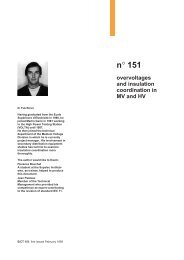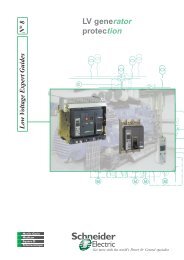Vigilohm System - engineering site - Schneider Electric
Vigilohm System - engineering site - Schneider Electric
Vigilohm System - engineering site - Schneider Electric
Create successful ePaper yourself
Turn your PDF publications into a flip-book with our unique Google optimized e-Paper software.
<strong>Vigilohm</strong>: functions and characteristics<br />
<strong>Vigilohm</strong> SM21 off-line insulation monitoring device<br />
051346<br />
use<br />
monitors de-energised equipment (e.g.<br />
motors, fire pumps,...) whatever the earthing<br />
system.<br />
De-energised installations:<br />
c AC (up to 690 V) or DC (up to 690 V);<br />
c when associated with a circuit breaker<br />
possessing an MN or MX release or with a<br />
contactor, the SM21 protects motors against<br />
insulation faults that may be produced<br />
during operating shutdowns (e.g. due to<br />
condensation), by initiating an alarm or<br />
startup lock-out.<br />
operation<br />
c injection of DC voltage.<br />
Voltage is applied, with the motor deenergised,<br />
between the stator and earth,<br />
thereby creating a leakage current in the<br />
motor insulation resistances;<br />
c 2 pre-set thresholds:<br />
v 1 prealarm threshold, adjustable in 8 steps<br />
from 0.5 to 10 MΩ,<br />
v 1 alarm threshold, adjustable in 8 steps<br />
from 0.25 to 2 MΩ.<br />
An electronic device measures insulation<br />
from the leakage current created by the<br />
voltage injected and activates the alarm or<br />
prevents starting when insulation drops<br />
below the corresponding threshold.<br />
installation and connection<br />
c live part in moulded, insulating,<br />
disconnectable, modular case, eight 9 mm<br />
modules wide, with transparent sealable<br />
cover;<br />
c horizontal or vertical mounting on<br />
symmetrical rail;<br />
c connection: wires up to 2.5 mm 2 ;<br />
c the SM21 is used with a contact that<br />
opens to disconnect the device from the<br />
installation when the installation is<br />
energised.<br />
type of de-energised installation to be monitored<br />
LV AC IT<br />
(de-energised)<br />
DC<br />
(de-energised)<br />
electrical characteristics<br />
phase-to-phase voltage i 690 V (1)<br />
frequency<br />
50-60-400-1000 Hz<br />
voltage between polarities i 690 V (1)<br />
fault signalling number of thresholds 2<br />
threshold values prealarm 0.5-1-1.5-2-3-5-<br />
± 15 % 7,5-10 MΩ<br />
alarm 0.25-0.5-0.75-1-<br />
1.25-1.5-1.75-2 MΩ<br />
response time<br />
i 1 s<br />
device operating test<br />
yes<br />
alarm inoperative yes by selector switch<br />
failsafe device (2) as standard (3)<br />
internal impedance DC 1.6 MΩ<br />
AC 50-60 Hz 350 kΩ<br />
changeover number alarm 1 standard<br />
output contact prealarm 1 failsafe<br />
breaking AC 230 V p.f. = 0.7 5 A<br />
capacity DC 120 V L/R = 1 ms 0.65 A<br />
auxiliary supply voltage 50/60 Hz 115/127 V AC<br />
220/240 V AC<br />
380/415 V AC<br />
440/480 V AC<br />
500/525 V AC<br />
auxiliary supply voltage tolerances - 15 % à + 10 %<br />
mechanical characteristics<br />
weight<br />
0.3 kg<br />
plastic case mounting horizontal/vertical<br />
degree of protection flush mounting IP 30<br />
surface mounting IP 20<br />
other characteristics<br />
temperature withstand for operation - 5 °C to + 55 °C<br />
for storage - 40 °C to + 70 °C<br />
climatic conditions (4)<br />
(1) depends on rated voltage withstand of the contact used to disconnect the SM21 when the network is energised.<br />
(2) failsafe: the relay is disactivated on occurrence of a fault or if the auxiliary supply voltage accidentally fails.<br />
(3) only the first alarm contact.<br />
(4) Suitable for use in all climates:<br />
c damp heat, equipment not operating (IEC 60068-2-30)<br />
c damp heat, equipment operating (IEC 60068-2-56)<br />
c salt mist (IEC 60068-2-52).<br />
standards<br />
IEC 61557-8.<br />
39

















